A Brief History
Back some time ago, in the early days of the pandemic, I stumbled onto this game. When I saw it, I was intrigued: it was a tile-laying game (something I enjoy) with a theme I just fell in love with. It was not long after that I backed it. I waited. The estimated delivery date was December 2020. Given the pandemic, I was unsure if this was realistic. As it turns out, Thematic Games must have planned things quite well for this campaign as I received my copies on November 27, 2020. Given that this was being shipped from Hong Kong, this is nothing short of miraculous. I have seen projects get mucked up in the fulfillment phase and get bogged down for months. They were actually ahead of schedule! It was a day or two later than my wife and I sat down to read the rules and give the game a try. We had an amazing time. Not long after, I introduced it to my younger child, and she loved it. It has become a family favorite.

Minigolf Designer
In the game, you will be attempting to design a minigolf course restricted to the shape and state of the land owned by the people hiring you; that land may be oddly shaped, or include some ponds/streams that can create difficulties in fitting the course into the space available. You will need to have nine holes and a total par as close to 36 as you can get it. Mr. and Mrs. Client have some things they really would like to see in the course as well.

The next section has a rather detailed description of the game play. If you would rather move on to my thoughts, then skip this section. Otherwise, click on the link below to dive into this game’s rules and mechanics!
Setup
- Randomly draw one Mr. Client and one Mrs. Client card. Put the remaining client cards back in the box.
- Each player selects a color and takes the components associated with that color. they place their personal score sheet and par cubes off to the side; they place their entrance gate in front of them in their play area.
- Deal three land cards randomly dealt to each player. They will select one of these and put the rest back into the deck. The deck is then returned to the box.
- Place the pond and stream tiles to the side in a pile where everyone can get to them if needed.
- Place the three racks in the center of the table. Put the player pawns on the topmost rack in a random order.
- Place a number of random minigolf course tiles on the second rack equal to the number of players plus one. Do the same for the third rack. Note: the tiles all have a number on the back of them (1-13). When placing tiles on a rack, draw them one at a time from the bag and place them face down (number side up); the tiles are then sorted into numerical order from lowest to highest with tied tiles placed in the order in which they were drawn.
- Decide if you want to play the family version, or the advanced version. Place the common scoreboard off to the side with the chosen side up.
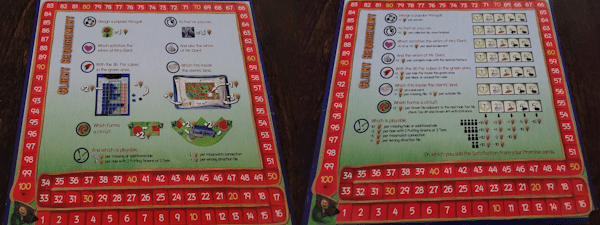
If you are playing the advanced game:
- Place a number of client visit tiles into the bag based on the player count (2 in a five-player game, 3 in a four-player game, 4 in a three-player game, or 6 in a two-player game).
- Each player places one or more of their promise cards and places it under their personal score sheet as a secret objective. The rest of their promise cards are placed in a face-down draw pile. If and when client visits take place, the player will be selecting more promises indicating things they have assured the clients will happen.
You are ready to begin!
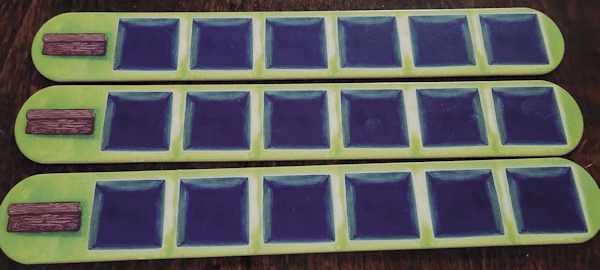
Game Play
Turn order is determined by the order in which the player pawns are positioned in the top-most rack. Players move left to right.
On a player’s turn, they may either select a tile from the second rack, place their player pawn in the spot where that tile was located, and play the tile in their minigolf course; or they may pass and place their player pawn on the park-bench at the far left of the rack. If other players are on the park bench, each new passing player goes to the leftmost spot on the bench.
When playing a tile, the tile must be placed into a space that is orthogonally or diagonally adjacent to a space they already have a tile, or in relation to their entrance gate (the water features do not count).
Once all players have taken their turn, move the now empty top-most rack and place it into the third position. Remove any unselected tiles from the new top-most rack. Place new tiles on the third rack. Put the unselected tiles back in the bag. The tiles the players took in the previous round (and/or their position on the park bench) will determine the player order for the next round.

In the advanced game, a tile might show up indicating a visit from the clients to check on your progress. If this happens, stop and resolve it before continuing. When it arrives, each player has the option of selecting one or more of their unselected promise cards and placing them under their personal score sheet.
Each promise card has an element of the final scoring, be that having a popular golf course (popularity is measured by how many people are pictured on the tiles placed in the course), completing the course on time (when a player fills their land, they will begin collecting minigolf course tiles as time tiles indicating the number of turns they completed prior to other players), and so on. So when the clients visit, if you think you are ahead or doing well in an area, then go ahead and make another promise to them. Otherwise, it might be wise to just pass on this.
Game Play: The End Game
Once a player has filled all of the spaces of their allotted land, the end game begins. Each round after that, all players who have filled their allotted land or have decided to stop will draw a tile (in player order, they cannot pass) and place it beside their course. This is a time tile and it is worth bonus points at the end of the game. Each other player must decide at the end of each turn if they wish to continue. They can stop at any time, but cannot change their minds once they do. Once all players have either filled their allotted land or called it quits, the game is over and it is time to score.
Winning the Game
Scoring the minigolf courses is a pretty straightforward affair. To start, each of the player pawns is placed on the common score sheet to the left of the 1-point spot. Each player (if they have not already) assigns each hole of their course a number (using the hole markers) and placed par cubes on their personal score sheet indicating the par of each hole (par is determined by flags that appear on many tiles; sum the number on the flags in a hole to get the par number). Then you can begin scoring.
Basic Scoring (for the family game) is the same as it is for the advanced game, only the promise cards are not used. Basic scoring is as follows:
- Fun—each player receives 1 point for each person pictured on the tiles within their course.
- Fast—each player who received time tiles scores 3 points for each time tile they acquired.
- Whims—each player scores bonus points for meeting the whims of Mr. and Mrs. Client. Each client has different expectations (from the length of holes, to the use of flowerbeds, to the number of dogs that come to their golf course, and so on). Depending upon the client, different elements of the course can be scored.
- Par—each individual hole should have a par of 3-5; for each hole that falls in this range, the player scores 2 points. Also, a minigolf course should have a total par of 36 for all nine holes. Each par above or below this target causes the player to lose -1 point. You will know how far you are below the target by the number of par cubes you had left over; you will know how far you are above the target value by the number of black par cubes you had to use to fill in your personal score sheet.
- Land—each land card has a value on it, usually 15-20 points. You score this many points automatically. However, you lose 1 point for each missing space within the allotted land, and 3 points for each tile that is outside the allotted land.
- Circuit—you will want hole #1’s tee, and hole #9’s putting green to be next to the entrance gate. Each other hole, you will want the putting green to be orthogonally adjacent to the tee for the next hole. For each of these conditions you meet, you get 2 points (for a total of 20 points, if you have a perfect circuit).
- Playable—You need nine holes; for each hole above or below this, you lose -10 points. Each hole needs a tee and a putting green; for each malformed hole, you lose -3 points. Tiles need to align with one another; for each tile that has a play area attached to a non-play area, you lose -3 points. Some tiles are directional (they can only be played in one direction because they have a ramp or some other feature that does not work the other way); for each tile going in the wrong direction, you lose -1point.
If you are playing the advanced game, you also need to score the promise cards.
- Promises—For each promise you made, you need to know how well you did compared to the other players. If, in that area of the game, you were the best, you score 10 points. If you were not, however, then you lose points based on how many players there were and how poorly you did. In four and five player games, you might score 1-2 points for second place. But if you come in last, you are losing -10 points. Thus, in a two-player game, a promise is either +10 points, or -10 points.
Score up each condition. If a player goes over 100 points, they place a score tile 100-points side up. If a player goes over 200 points, they flip their score tile over to show the 200-point side.
The player with the highest score wins.
So Much Silly Fun!
There are games where, as you complete your turn, you find yourself laughing on the inside (and sometimes on the outside). When I first discovered Robo Rally, there came that moment when I noticed that I was contorting my body to try and figure out which direction my robot would be moving in each phase of my program. When I first discovered Carcassonne, there came that moment when you realize that this might be a Euro game, but it can most certainly be a vicious one! When I first discovered Sagrada, there came that moment when you realize that something you did three turns ago is going to make this turn very, very rough.
In each of these games, there is a wondrous learning curve of discovery where you see that the game has depth beyond your initial assessment. It is around game two or three of Minigolf Designer that you start to see that things are not all created equal. You get points for a lot of things, so which ones should you go for?
- Mr. and Mrs. Client may or may not be the wisest choice to listen to. Sure, following their directions will get you points, but at what cost? In my example game (below), I followed Mr. Client’s advice to my peril.
- Your opponents get points if they have completed their course for each turn you continue to work on yours. If you do not complete things, you get a penalty. So when is it best to just stop and take the penalty, and when it is best to plow forward and get things done? This is a question that can only be answered by looking carefully at your course, and those of your opponents.
- The par of each hole is important. But the overall par can be even moreso. Watching this and knowing what you need is imperative.
- Pay attention to the land you have available. Miscounting the number of spaces you have in some element of your plot can be very detrimental.
- Keep track of the number of holes and the circuit they make. This is very important in the end.
This game is a lot like Sagrada, in the sense that you will often make a mistake in an early turn that will not be noticed until late in the game when you realize you have accidentally created an extra hole (or neglected to leave enough room for one), or you made a hole with two putting greens, or what have you. But all of this is part of the joy and shared laughter of this little puzzle.
And it never gets old.
A Couple of Examples
In a recent game between my wife and me, this was my final situation:
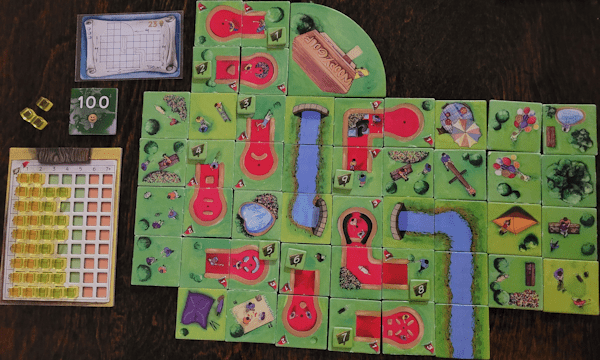
Mr. Client wanted short holes and Mrs. Client was looking for flower beds. This made getting my par values correct a bit difficult (I had three left-over cubes). In the end I did not do too badly.
This was my wife’s final situation:
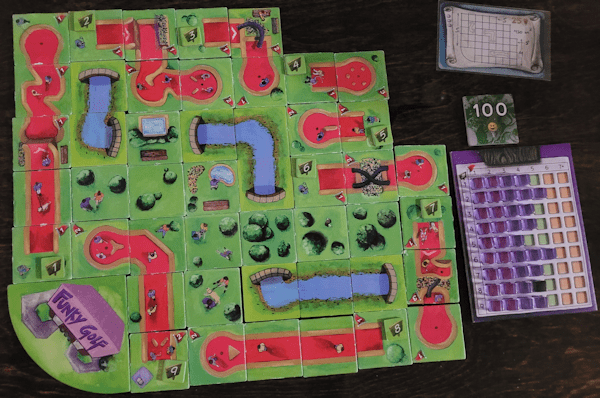
She decided to mostly ignore Mr. Client thanks to the layout of her land. She struggled with par as well, having to use a black cube at the end.
This was our score:
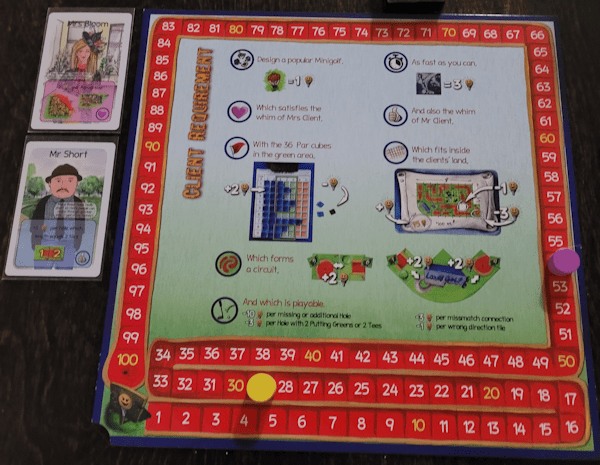
I put too much faith in the following of Mr. Short’s requirement of two-tile holes (it cost me). I did better with getting the flowerbeds Mrs. Bloom was looking for. Still, as you can see, she won (154 to 129). The game was a blast! It always is.
Conclusion
I love this game! It has a fun, light-hearted theme. The puzzle you are trying to solve is challenging and changes from game to game. There is a bit of luck, but this is mitigated with the ability to pass and ensure a relatively high spot in the turn order next turn. The whims and land cards are fun to try and fulfill as much as you can. The mistakes you make are often not noticed for several turns—and everyone gets a good laugh when they are discovered. The whole game is beautiful and fun to play. Several elements, like the racks and how they impact player order, are things I would like to try in other games (such as Carcassonne).
I cannot think of a single thing I could say detracts from the beauty and fun of this game. If you are looking for a medium-light game accessible and fun for young kids while being fun for adults, you cannot go wrong with Minigolf Designer.
It is really a wonderful game that I cannot recommend enough.


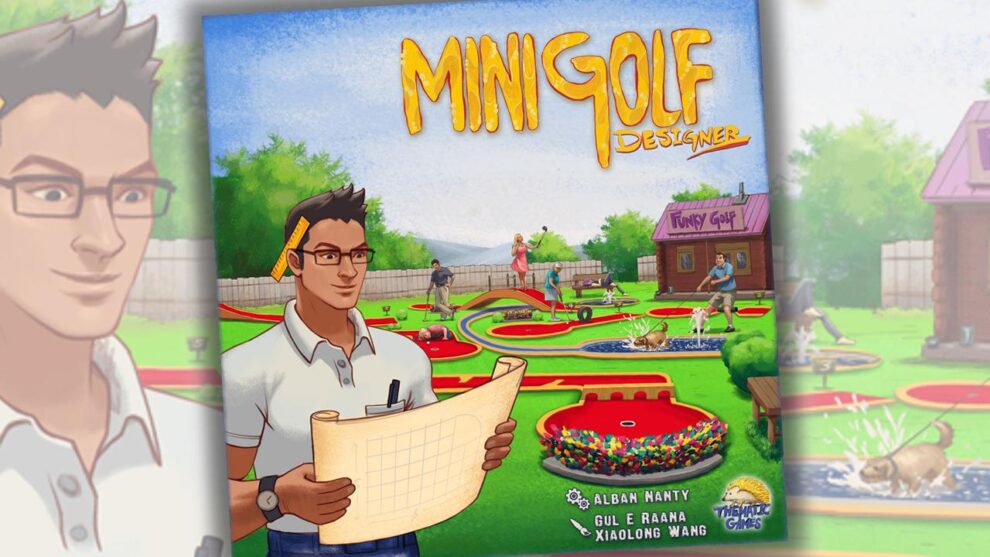








I’ve been looking for this game for 6 months!
Keep looking — it is worth it!
When I backed the campaign, I got two copies. One for me, one for my friend Mike.
I am not sure Mike likes it as much as I do. I can check to see if he would be willing to part with it, if you like.
Thanks for this nice review David! I’m happy that you love it so much!
FYI, we recently reprinted the second edition, and the game is currently available in our online store for those interested.
Hi Alban! It has been a while!
Yes — I hope people check out your store!
https://www.thematicgames.com/